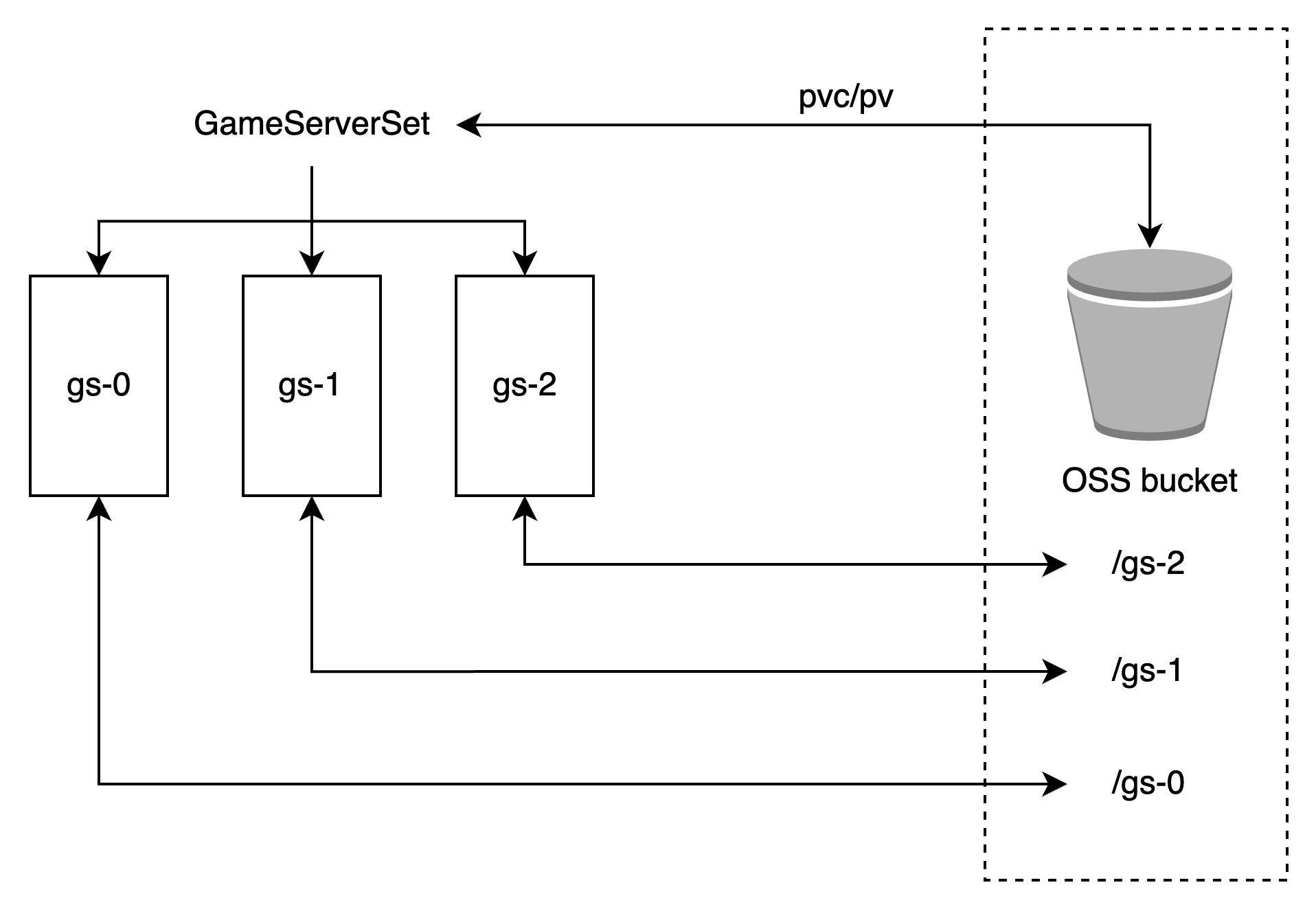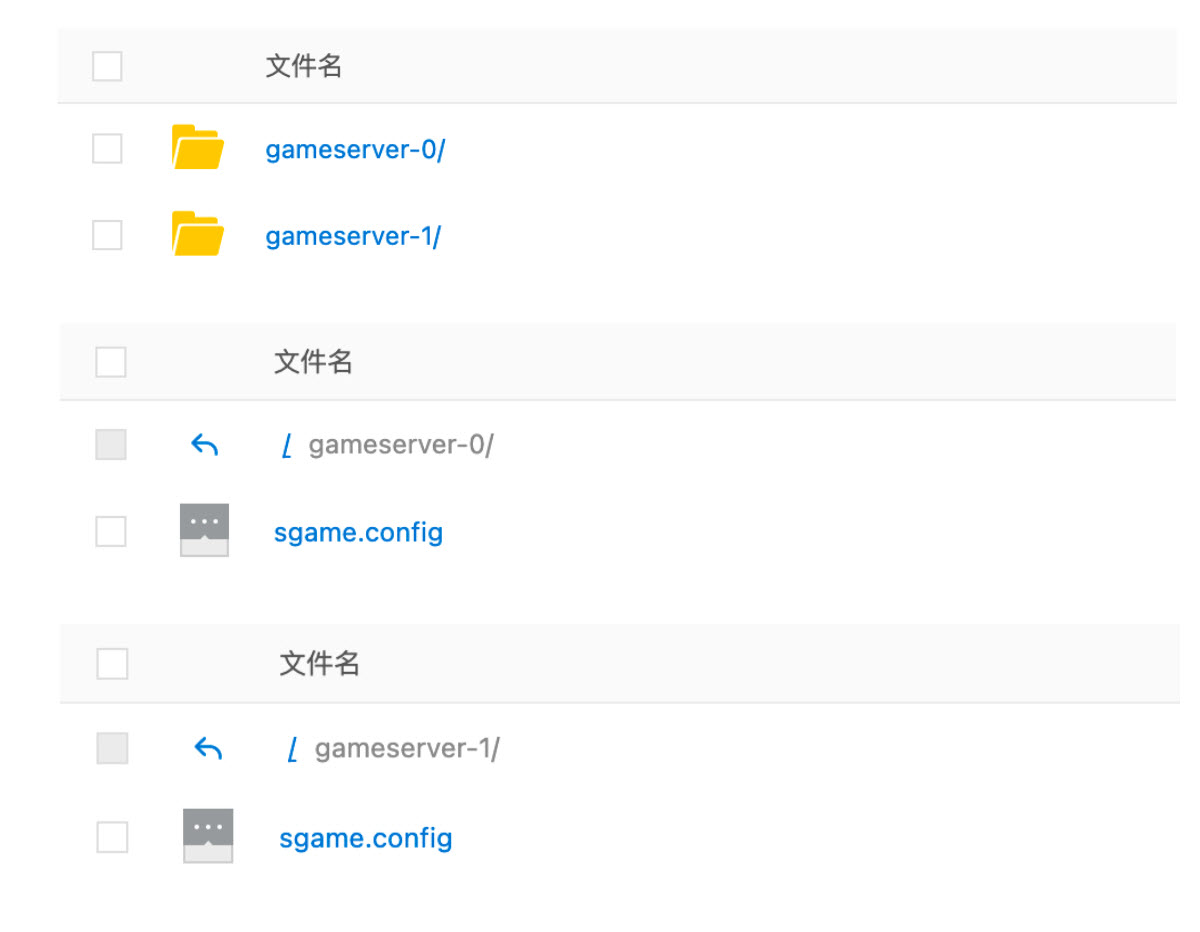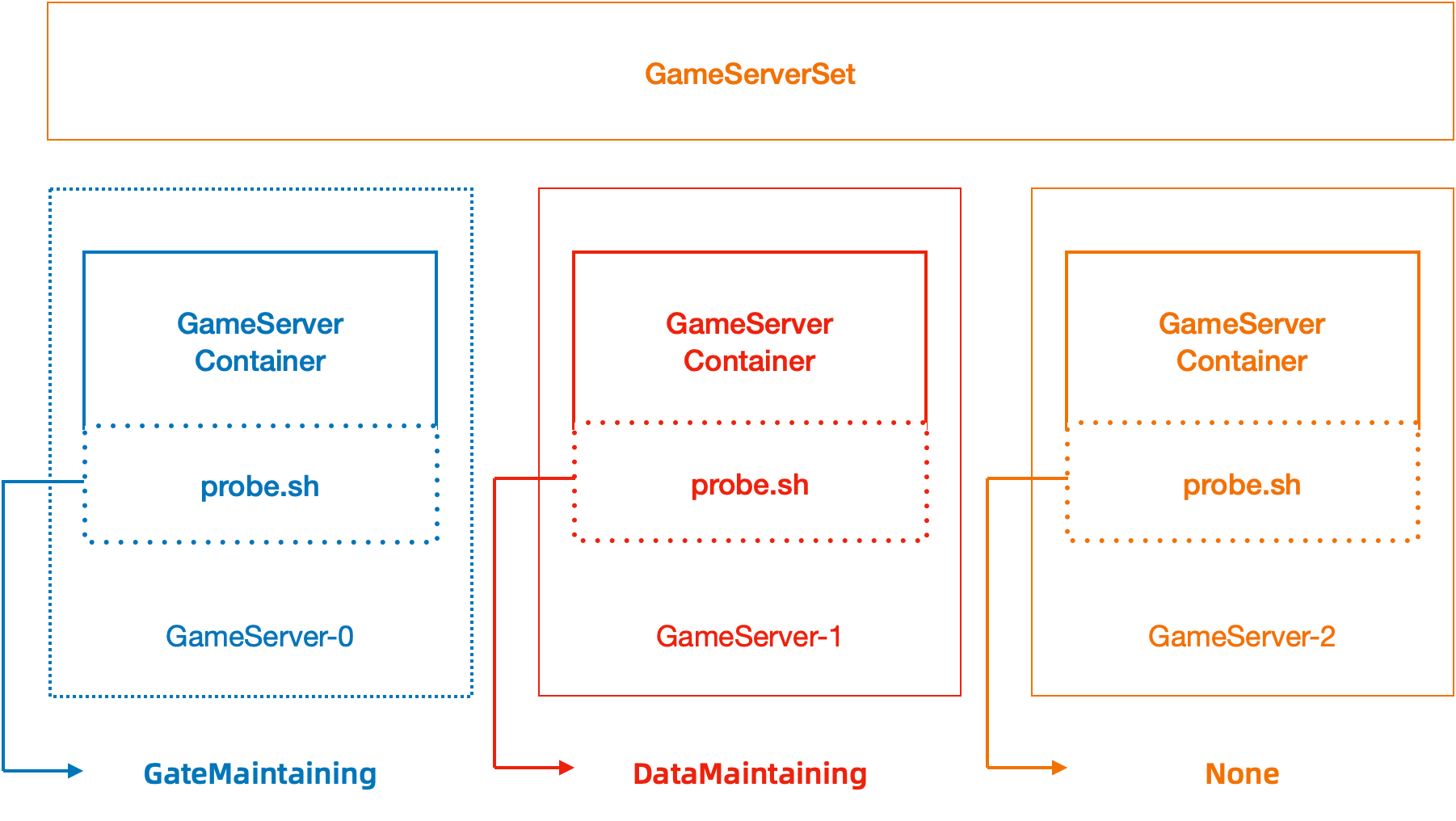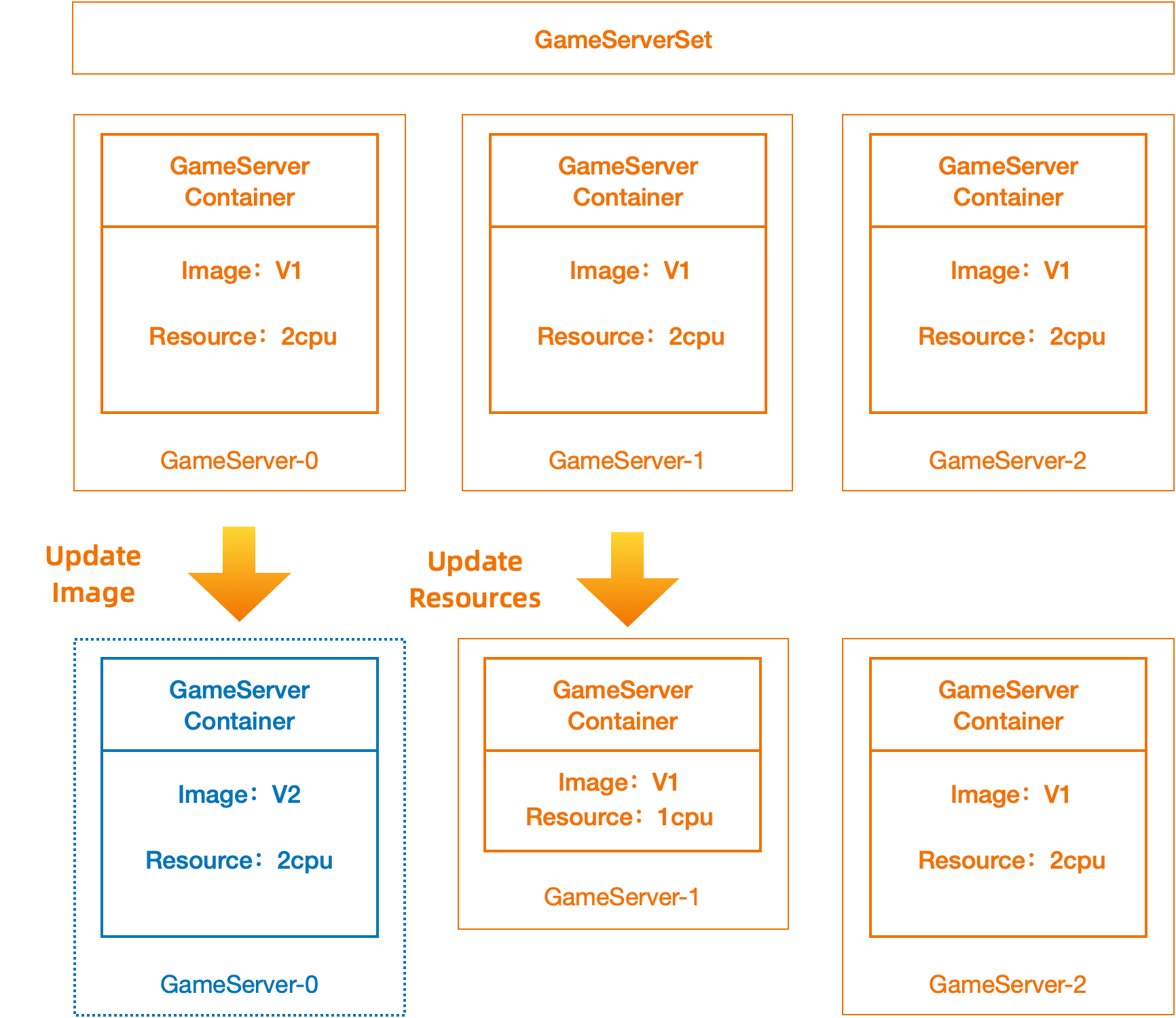By ChrisLiu
Firstly, PvE server-based games have the following characteristics:
When implementing such games on Kubernetes, developers often face a dilemma due to:
If using Kubernetes native workloads, it is impossible to manage game services with precision, specifically:
If using Deployments for management:
If using StatefulSets for management:
If not using Kubernetes native workloads, the capabilities of Kubernetes orchestration cannot be utilized:
If using script programs for batch server launches:
If using gitops for management:
If managing through a self-built PaaS platform:
This best practice guide will introduce how to manage server-based game services using OpenKruiseGame (OKG).
The in-place upgrade hot update provided by OKG is a more cloud-native approach to implementing hot updates for game servers. This method enables version management of hot update files for game servers, phased rollouts, update status awareness, and consistency of hot update versions after failure recovery.
For specific implementation methods, please refer to the relevant documentation
Game servers managed by GameServerSet have a numerical property, and their names are fixed and unchanging, similar to StatefulSet. Therefore, "GameServerSet name + number" can serve as a unique identifier for the game server, linking to distributed storage or configuration management systems for differentiated configuration management.
Through object storage, the different configurations of different game servers are placed under paths named after the game server names, ensuring that the bucket's path corresponds one-to-one with the game servers. This is declared as a PVC (Persistent Volume Claim) on GameServerSet. The schematic diagram for this method is as follows:

GameServerSet Yaml:
apiVersion: game.kruise.io/v1alpha1
kind: GameServerSet
metadata:
name: gameserver
namespace: default
spec:
replicas: 2
updateStrategy:
rollingUpdate:
podUpdatePolicy: InPlaceIfPossible
gameServerTemplate:
spec:
containers:
- image: registry.cn-hangzhou.aliyuncs.com/acs/minecraft-demo:1.12.2
name: minecraft
env:
- name: POD_NAME
valueFrom:
fieldRef:
apiVersion: v1
fieldPath: metadata.name
volumeMounts:
- name: pvc-oss
mountPath: "/app/sgame.config"
subPathExpr: $(POD_NAME)/sgame.config
volumes:
- name: pvc-oss
persistentVolumeClaim:
claimName: pvc-ossAs such, before launching the server, it is only necessary to prepare the corresponding configurations for the game server and upload them to the respective paths in the bucket. Then, deploy the GameServerSet or adjust the Replicas as needed.
As shown in the diagram, the file contents in the directories gameserver-0 and gameserver-1 are different and will be mounted on the corresponding game servers gameserver-0 and gameserver-1, respectively:

If there is a configuration center service (such as Nacos) in the business, by utilizing the characteristic that the game server name is fixed and unique, the game server container can pull the corresponding configuration by sending a request to the configuration center with its own name as the request parameter at startup. The method of obtaining the container's own name is similar to that used in mounting object storage, where it is passed in as an environment variable through the DownwardAPI.
When traditional server-based games are containerized, they often exist in the form of "rich containers," meaning that a single container may have multiple processes, each responsible for different functions of a single server. At this point, the status of a single game server can be quite complex. Native Kubernetes manages business status at the container level and cannot finely perceive the status of specific processes within the container, making it difficult to locate and address faults or anomalies.
OKG believes that the service quality of game servers should be defined by the user. Users can set the status of game servers based on their business needs and handle it in a detailed manner. OKG's "custom service quality" feature detects specific abnormal process states and exposes them to the Kubernetes side. By using components such as kube-event for event notification, alerts can be sent to operations groups, helping operations engineers quickly discover issues, achieving second-level fault localization and minute-level fault resolution.
The diagram below illustrates the custom service quality feature. Based on the results returned by the probe.sh script, the operational status of the GameServer is changed, enabling rapid localization of faults/anomalies:

Let’s take an example to see how to realize multiple status awareness of the game server through a detection script.
When making a container image, write a script to detect the status of the container. The sample script probe.sh will detect whether the gate process and data process exist. When the gate process does not exist, it outputs "gate" and exits normally; when the data process does not exist, it outputs "data" and exits normally; when there is no exception, it exits with exit code 1.
The probe.sh script is a detection script within the business container, which is periodically called by OKG. Its principle is similar to the Kubernetes native liveness/readiness probes. In the aforementioned scenario, the pseudocode for probe.sh is as follows:
#!/bin/bash
gate=$(ps -ef | grep gate | grep -v grep | wc -l)
data=$(ps -ef | grep data | grep -v grep | wc -l)
if [ $gate != 1 ]
then
echo "gate"
exit 0
fi
if [ $data != 1 ]
then
echo "data"
exit 0
fi
exit 1The corresponding yaml of GameServerSet is as follows:
apiVersion: game.kruise.io/v1alpha1
kind: GameServerSet
metadata:
name: minecraft
namespace: default
spec:
replicas: 3
updateStrategy:
rollingUpdate:
podUpdatePolicy: InPlaceIfPossible
maxUnavailable: 100%
gameServerTemplate:
spec:
containers:
- image: registry.cn-beijing.aliyuncs.com/chrisliu95/minecraft-demo:probe-v0
name: minecraft
serviceQualities:
- name: healthy
containerName: minecraft
permanent: false
exec:
command: ["bash", "./probe.sh"]
serviceQualityAction:
- state: true
result: gate
opsState: GateMaintaining
- state: true
result: data
opsState: DataMaintaining
- state: false
opsState: NoneAfter the deployment is completed, 3 Pods and GameServer are generated
kubectl get gs
NAME STATE OPSSTATE DP UP AGE
minecraft-0 Ready None 0 0 14s
minecraft-1 Ready None 0 0 14s
minecraft-2 Ready None 0 0 14s
kubectl get po
NAME READY STATUS RESTARTS AGE
minecraft-0 1/1 Running 0 15s
minecraft-1 1/1 Running 0 15s
minecraft-2 1/1 Running 0 15sEnter the minecraft-0 container, simulate the gate process failure, and kill its corresponding process number.
kubectl exec -it minecraft-0 /bin/bash
/data# ps -ef
UID PID PPID C STIME TTY TIME CMD
root 1 0 0 03:00 ? 00:00:00 /bin/bash ./start.sh
root 7 1 0 03:00 ? 00:00:00 /bin/bash ./gate.sh
root 8 1 0 03:00 ? 00:00:00 /bin/bash ./data.sh
root 9 1 99 03:00 ? 00:00:24 java -jar /minecraft_server.
...
/data# kill -9 7
/data# exitGet the opsState of the current gs, which has changed to GateMaintaining
kubectl get gs
NAME STATE OPSSTATE DP UP AGE
minecraft-0 Ready GateMaintaining 0 0 2m14s
minecraft-1 Ready None 0 0 2m14s
minecraft-2 Ready None 0 0 2m14sEnter the minecraft-1 container, simulate the data process failure, and kil its corresponding process number.
kubectl exec -it minecraft-1 /bin/bash
/data# ps -ef
UID PID PPID C STIME TTY TIME CMD
root 1 0 0 03:00 ? 00:00:00 /bin/bash ./start.sh
root 7 1 0 03:00 ? 00:00:00 /bin/bash ./gate.sh
root 8 1 0 03:00 ? 00:00:00 /bin/bash ./data.sh
root 9 1 99 03:00 ? 00:00:24 java -jar /minecraft_server.
...
/data# kill -9 8
/data# exitGet the opsState of the current gs, which has changed to DataMaintaining
kubectl get gs
NAME STATE OPSSTATE DP UP AGE
minecraft-0 Ready GateMaintaining 0 0 3m10s
minecraft-1 Ready DataMaintaining 0 0 3m10s
minecraft-2 Ready None 0 0 3m10sEnter minecraft-0 and minecraft-1 respectively, and manually pull up the hung process:
kubectl exec -it minecraft-0 /bin/bash
/data# bash ./gate.sh &
/data# exit
kubectl exec -it minecraft-1 /bin/bash
/data# bash ./data.sh &
/data# exitAt this time, the operation and maintenance status of gs has returned to None.
kubectl get gs
NAME STATE OPSSTATE DP UP AGE
minecraft-0 Ready None 0 0 5m6s
minecraft-1 Ready None 0 0 5m6s
minecraft-2 Ready None 0 0 5m6sThere are two types of lifecycle reclaim policies for GameServers — Cascade and Delete, which can be set in GameServerSet.Spec.GameServerTemplate.ReclaimPolicy.
The Cascade policy is suitable for short-lifecycle game servers, where there is a frequent need for starting and deleting sessions and the state needs to be cleared promptly, such as in most PvP session-based games. The Delete policy, on the other hand, is more suitable for traditional PvE games with dedicated servers, where the game server's state needs to be recorded on the GameServer for a long time to prevent loss of state. It is only reclaimed when the user performs server merging or deletion operations. Explicitly declaring the GameServer reclaim policy as Delete when creating a GameServerSet can better achieve targeted management functions for dedicated server games.
Scenarios, where targeted updates of game server images are necessary, exist, including:
For such cases, where a single GameServerSet might have multiple versions of an image for game servers, one can specify the update for a specific game server image version by setting the image field in GameServer.Spec.Containers.
Scenarios, where targeted updates of game server images are necessary, include:
For situations where a single GameServerSet might have game servers with various resource specifications, one can specify the specific resource specification for a game server by setting the resources field in GameServer.Spec.Containers.
The diagram illustrating the targeted update of game server image and resource specification is as follows:

Next, an example will be shown to demonstrate how to conduct targeted updates of the game server's image and resource specifications.
Firstly, deploy a GameServerSet with 3 replicas:
apiVersion: game.kruise.io/v1alpha1
kind: GameServerSet
metadata:
name: minecraft
spec:
replicas: 3
gameServerTemplate:
reclaimPolicy: Delete
spec:
containers:
- image: registry.cn-hangzhou.aliyuncs.com/acs/minecraft-demo:1.12.2
name: minecraft
rollingUpdate:
podUpdatePolicy: InPlaceIfPossible
maxUnavailable: 100%Update image of gs minecraft-0 to registry.cn-hangzhou.aliyuncs.com/acs/minecraft-demo:1.12.2-new
kubectl edit gs minecraft-0
...
spec:
deletionPriority: 0
opsState: None
updatePriority: 0
# add
containers:
- name: minecraft
image: registry.cn-hangzhou.aliyuncs.com/acs/minecraft-demo:1.12.2-new
...After a while, pod updated(number of restarts add 1 because of inplace-update)
kubectl get po
NAME READY STATUS RESTARTS AGE
minecraft-0 1/1 Running 1 (13s ago) 3m28sAt this point, if a pod is deleted, the image of the newly created pod will be based on the spec declared in the GameServer. For example:
# delete pod
kubectl delete po minecraft-0
# pod state is Terminating, gs state is Deleting
kubectl get gs minecraft-0
NAME STATE OPSSTATE DP UP AGE
minecraft-0 Deleting None 0 0 8m19s
kubectl get po minecraft-0
NAME READY STATUS RESTARTS AGE
minecraft-0 1/1 Terminating 1 (5m12s ago) 8m19s
# after a while
# pod running again,age of GameServer is different from age of pod
kubectl get po minecraft-0
NAME READY STATUS RESTARTS AGE
minecraft-0 1/1 Running 0 28s
kubectl get gs minecraft-0
NAME STATE OPSSTATE DP UP AGE
minecraft-0 Ready None 0 0 9m18sSince the GameServer's recycling policy is set to Delete, the configuration of the game server will not be lost due to the disappearance of the pod. The current game server's image remains the updated one: registry.cn-hangzhou.aliyuncs.com/acs/minecraft-demo:1.12.2-new.
Next, we will perform a targeted update of the resource specifications for the game server minecraft-1, adjusting the requests to cpu: 500m:
kubectl edit gs minecraft-1
...
spec:
deletionPriority: 0
opsState: None
updatePriority: 0
# add
containers:
- name: minecraft
resources:
requests:
cpu: 500m
...The resource configuration will not be updated in place immediately. The new resource specifications will take effect once the maintenance period begins, and the operations engineer manually triggers the pod to be rebuilt. For example:
kubectl delete po minecraft-1
# after a while
# gs won't be deleted
kubectl get gs minecraft-1
NAME STATE OPSSTATE DP UP AGE
minecraft-1 Ready None 0 0 15m
# pod recreated
kubectl get po minecraft-1
NAME READY STATUS RESTARTS AGE
minecraft-1 1/1 Running 0 11sAt this moment, the pod's resource specification for requests has been adjusted to cpu: 500m.
When the player base of a particular game server declines to a certain extent and server merging is required, targeted deletion of game servers can be performed.
Q: How to decide the scope of management for a GameServerSet?
First and foremost, it's important to understand that a GameServerSet (abbreviated as gss) is a cluster-level resource and cannot be declared across clusters. Secondly, PvE-type games often involve concepts like zones and groups, which add several dimensions. As such, should a single zone use one gss, or should a single group use one gss? In reality, the decision mainly depends on the initial differences between these game servers.
The considerations for differences can generally be assessed from two aspects:
1) They are consistent initially but diverge over time.
2) They are inconsistent from the start. For the first scenario, a single GameServerSet can manage the game servers, and the targeted update function of OKG mentioned earlier can be used. For the second scenario, a single GameServerSet can also manage the game servers, but the operations required when opening new servers become more complex, involving not just adjusting the number of replicas but also adjusting the Spec of the corresponding GameServer to have its own image or resource configuration. This method is more suitable for a testing environment or a production environment with a smaller number of game servers. In cases where there is a large number of game servers, it is recommended to have specifications defined so that game servers with the same image and the same resource specifications are managed by the same GameServerSet.
Q: How to open a new game server?
The steps for opening a new game server are as follows:

513 posts | 50 followers
FollowAlibaba Container Service - July 16, 2024
Alibaba Container Service - July 5, 2024
Alibaba Cloud Native Community - November 15, 2023
Alibaba Cloud Native Community - November 15, 2023
Alibaba Container Service - July 5, 2024
Alibaba Cloud Native Community - October 19, 2022

513 posts | 50 followers
Follow Cloud-Native Applications Management Solution
Cloud-Native Applications Management Solution
Accelerate and secure the development, deployment, and management of containerized applications cost-effectively.
Learn More Gaming Solution
Gaming Solution
When demand is unpredictable or testing is required for new features, the ability to spin capacity up or down is made easy with Alibaba Cloud gaming solutions.
Learn More Managed Service for Prometheus
Managed Service for Prometheus
Multi-source metrics are aggregated to monitor the status of your business and services in real time.
Learn More Container Service for Kubernetes
Container Service for Kubernetes
Alibaba Cloud Container Service for Kubernetes is a fully managed cloud container management service that supports native Kubernetes and integrates with other Alibaba Cloud products.
Learn MoreMore Posts by Alibaba Cloud Native Community